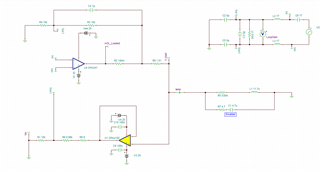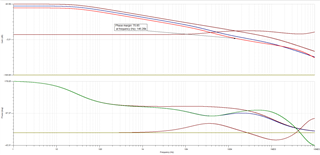- Ask a related questionWhat is a related question?A related question is a question created from another question. When the related question is created, it will be automatically linked to the original question.
Hi Gautam,
welcome to the E2E forum!
I can help check for stability.
Essentially, we need to break the loop of the OPA to measure its AC response over frequency while maintaining linear operating condition.
Since we have a MFB loop with another OPA, this can get somewhat confusing.
I am going to state U1 to be stable as this device is unity gain stable, and there is no inductive or capacitive loading on the inverting input or output pin of U1.
This means we only need to analyze the open loop response of U4:
The definition of stability is the phase shift seen in the loop gain phase curve at the frequency where the loaded AOL curve intersects with 1/beta.
Here, I modify your circuit to open the feedback loop, and I add a VCC resource to U4 to ensure linear operating condition.

Now when I run my AC analysis, I get the desired curves needed: (Loaded AOL, 1/Beta, LoopGain)
I can use the Phase Margin tool in TINA-TI to get the phase margin of the loop gain curve:

Here we can see that we have about 70 degrees of stability: perfectly stable.
My only feedback on this circuit is to make sure we do not connect +-25V Vs to the OPAx182. If this is not an option on your board, I can recommend a HV amplifier which can tolerate 50V Vs.
Please let me know if you have any questions.
Best,
Jacob
No problem,
If you need 50V Vs, I recommend using the OPA596. This device is currently in preview, but it uses a standard DBV5 (SOT-23 -5) package. This is an 85V device, so 50V Vs is no problem. I believe this device is expected to release to full production in less than two months.
If you need an immediate solution right now, we also have the OPA593 which is currently in full production. Note that this device is also 85V process, but this is going to be more of a power amp rather than a HV op amp.
I am certain this device would still get the job done for your task, but it will be way more output current drive than you would realistically need for U1. Consequently, OPA593 will be more expensive than OPA596 and the device uses a non-standard package to allow for a large bottom mount thermal pad.
We have spice models available for both devices if you want to try them out in simulation.
Please let me know if you have any questions.
Best,
Jacob